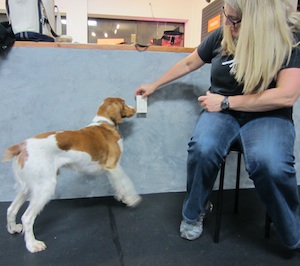Clicker Training Misconceptions Clarified

Cooper learns to hit the lights with clicker training.
During the first session of a new dog obedience class, we always ask “Who has used clicker training?” Out of ten students, maybe one person raises their hand (if we are lucky). When we ask “Who has heard of clicker training?,” almost everyone raises their hand. So, if everyone knows about it, why don’t more people use it?
We’ve asked that question of many clients and learned that there is a lot of confusion about clicker training. Hopefully we can clear some of that up by addressing some of the most common clicker misconceptions:
- Clicker training is aversive. FALSE. Clicker training uses positive reinforcement to mark a behavior with a distinctive sound and tell the dog that you like what he did. A reward always follows the click and there is no punishment involved!
- The clicker is used to get my dog’s attention or to tell him to do something. FALSE. The click should come at the time your dog performs a desired behavior, not beforehand. A click will get your dog’s attention because he is expecting a treat when he hears the click, but you will be rewarding what ever it was that he was doing when you clicked (which may not be something you want to reinforce!).
- I will have to carry a clicker for the rest of my dog’s life. FALSE. The clicker is used primarily when teaching a new behavior. Once your dog knows the behavior, you do not need to continue to click and reward every time. You can always reinforce a learned behavior with praise!
- My dog will learn to work only for treats. FALSE. Clicker training actually makes it easier to fade treats from the training process. Dogs learn faster with the precision of the clicker so luring with treats can be eliminated sooner. Additionally, the clicker acts as a bridge between the behavior and the reward, so you can mark the behavior at the precise moment the dog performs it and deliver the reward several seconds later. You don’t need to have treats on your person – they can even be in another room!
- I can’t handle the clicker, the leash, and the treats at once. TRUE and FALSE. It can be challenging to juggle all those things since you only have two hands, but with a little practice anyone can do it. If you need a treat for luring the behavior, the leash and clicker can be held in one hand and the treat in the other. Once you have moved from the luring stage to reward (where the treat is presented AFTER the behavior is performed), you don’t need treats in your hand at all – they can be in a bait bag, pocket, or on a table somewhere nearby.
- My dog is scared of the clicker. CAN BE TRUE, BUT IS EASILY CORRECTED. Some sound sensitive dogs can be startled by the sound of the clicker at first. You can prevent or correct this by purchasing a gentle clicker with a softer sound and introducing the clicker some distance away from the dog. Once your dog realizes a click means a treat is coming, they will get over any nervousness about it. Be sure to never click near your dog’s ears as that can hurt!
- My dog is too old for clicker training. FALSE. No dog is too old to learn and clicker training is one of the best methods to teach new things or eliminate undesirable behaviors at any age or or with any breed. Dogs love clicker training and will try all kinds of stuff to get you to click and reward them.
Learn how easy it is to teach your dog new tricks using a clicker by enrolling in one of our classes today!
Stop in to buy a gentle clicker and check out our other great training gear – among other things, we’ve got bait bags, long lines, beautiful leather leads, and an excellent assortment of all-natural treats perfectly sized for training.


Leave a comment